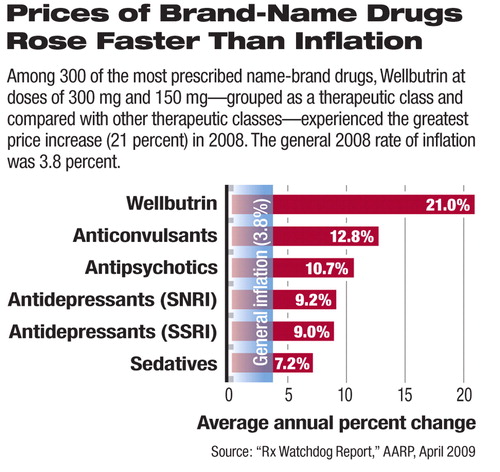Price of Brand-Name Psychiatric Drugs on Steep Upward Course
Manufacturer prices for brand-name prescription drugs widely used by Medicare beneficiaries jumped by nearly 9 percent in 2008, according to the 2009 AARP “Rx Watchdog Report.”
That increase was the largest annual increase in six years and greatly exceeded the general inflation rate of 3.8 percent.

Major classes of psychiatric brand-name drugs—including antidepressants, antipsychotics, sedatives, antidementia agents—experienced price increases that exceeded general inflation. Grouped in a class and compared with all other therapeutic drug categories, two dosages of Wellbutrin (300 mg and 150 mg) experienced the greatest increase, rising in price by 21 percent (see chart).
Meanwhile, manufacturer prices of widely used generic drugs continued to decrease in 2008, falling by an average of 10.6 percent. The majority of generics (83 percent) did not change in price in 2008, despite an increase in general inflation.
And some of the generics that did drop in price did so very dramatically. For instance, the manufacturer price for the brand-name antidepressant Zoloft (50 mg and 100 mg tablets) increased by 12.3 percent in 2008, but the price for generic sertraline made by Teva Pharmaceuticals decreased by 45.1 percent, according to the report.
“A person taking three brand-name prescription drugs could see his or her annual costs climb by more than $550 in just one year,” AARP Public Policy Director John Rother said in a statement released with the report.“ Switching to generic drugs whenever possible is one of the quickest and easiest ways to drastically reduce health care bills.”
The list of prescription drugs widely used by Medicare beneficiaries is based on the 300 most widely dispensed drug products, the 300 drug products with the highest sales levels, and the 300 drug products with the highest number of days of therapy among the prescriptions provided by United Healthcare-PacificCare. (That company provides Medicare Part D coverage and is also the organization that insures the AARP Medicare Rx Plans.)
Price changes were measured using changes in the wholesale acquisition cost as published by the Medi-Span Price-Chek PC Database.
AARP's “Rx Watchdog Report” is posted at<http://assets.aarp.org/rgcenter/health/2009_07_rxq408.pdf>.▪



